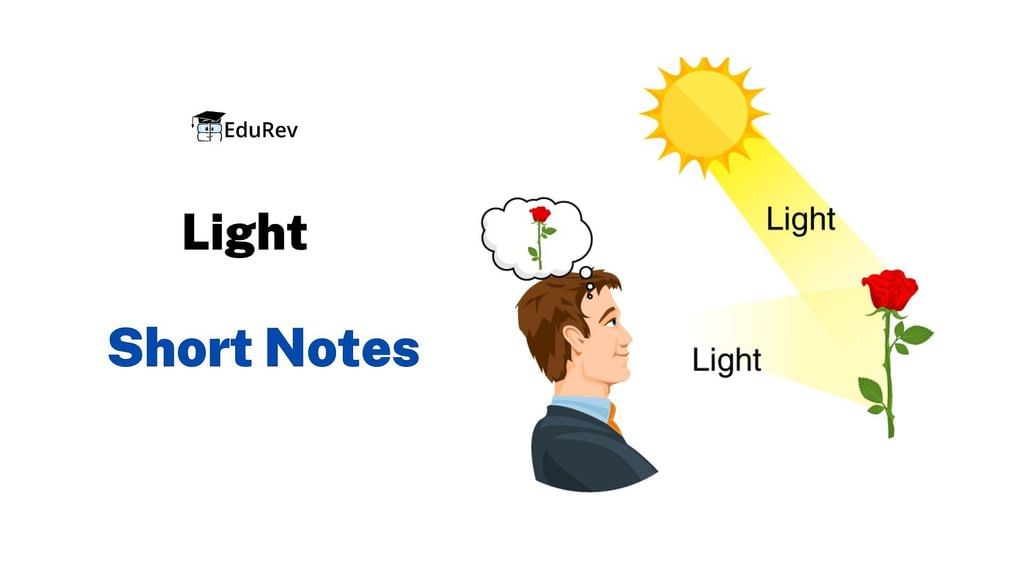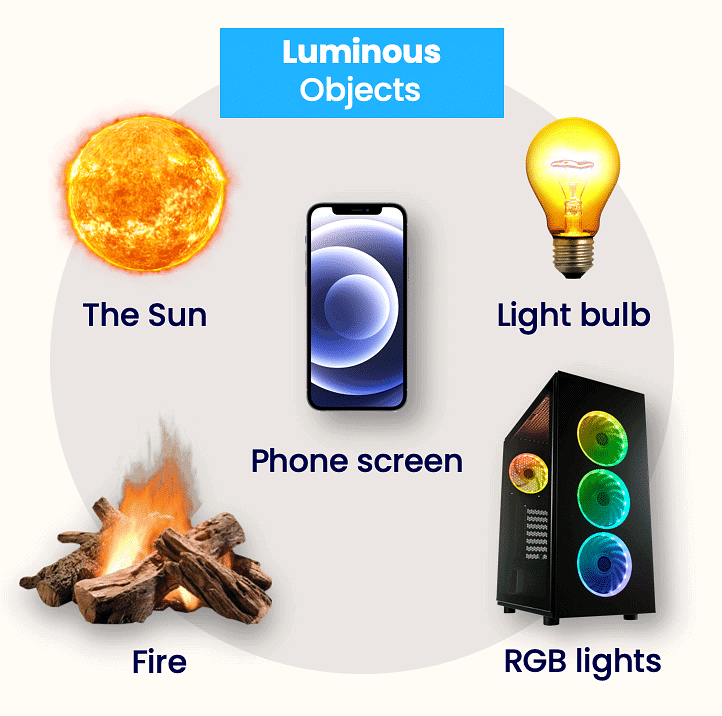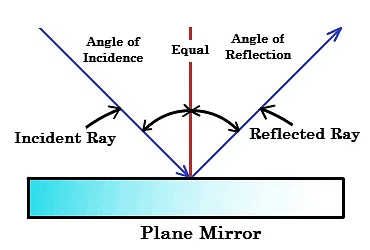Light Class 8 Notes Science Chapter 13
What is Light?
Light is a fascinating form of energy that plays a crucial role in our daily lives. It allows us to see the world around us and experience the vibrant colors, shapes, and textures of our surroundings.

- When light enters our eyes, it triggers a process that enables us to perceive and understand our environment.
- Light can come from various sources, such as the Sun, which emits its own light, or from objects that reflect light, like the Moon or a shiny surface.
- Understanding the properties and behaviors of light helps us unravel the mysteries of the universe and opens up countless possibilities for scientific discoveries and technological advancements.
Let us learn more about Light through the short notes in this document.
What Makes Things Visible?
The visibility of objects relies on the presence and interaction of light. Light, being a type of energy, stimulate our visual perception and enables us to observe the world around us. This light can originate from either self-illuminating sources or as reflected light.

- Luminous objects refer to those that emit light independently. For instance: the Sun, light bulbs, and tube lights. Example: Sun, bulb, tube light
- Non-luminous objects are objects which reflect light from other sources. They do not emit light of their own. Example: Moon, tree, table, painting.

Laws of Reflection
- When light hits a mirror, it undergoes reflection.
- The incident ray is the incoming ray of light that strikes the mirror.
- The reflected ray is the outgoing ray that bounces off the mirror's surface.
- We use a line called the "normal" to understand the process.
- The normal is drawn perpendicular to the mirror's surface at the point of incidence.

- Here's something really cool: the incident ray, the reflected ray, and the normal all lie on the same plane, which means they exist in the same flat surface. Now, when we measure the angles, we have the "angle of incidence," which is the angle between the incident ray and the normal. And then we have the "angle of reflection," which is the angle between the reflected ray and the normal.
- Here's an important rule to remember: the angle of reflection is always equal to the angle of incidence. So, if the incident ray hits the mirror at a certain angle, the reflected ray will bounce off at the same angle. This rule helps us understand how light behaves when it interacts with mirrors.
Regular and Diffused Reflection
Reflection Types:
- Regular Reflection: Occurs when parallel rays of light bounce off a smooth surface, remaining parallel after reflection (e.g., a mirror). The resulting image is clear and well-defined.

- Diffused Reflection: Happens when parallel rays of light reflected from a surface scatter in various directions due to irregularities on the surface, like rough materials (e.g., cardboard). Although not violating reflection laws, diffused reflection does not form distinct images and spreads light in different directions.

Reflection Effects:
- Regular reflection is responsible for forming clear images.
- Diffused reflection, without forming distinct images, scatters light in various directions.
Understanding these reflection types helps us grasp how light interacts with different surfaces, influencing our perception of the surrounding environment.
Reflected Light Can be Reflected Again
- Hair Salon Mirror
- At the hairdresser, after cutting your hair, they show you the back using a mirror held behind you.
- Periscope it uses two plane mirrors.
How Periscope Works
- Reflection from these mirrors helps see objects not directly visible.
- Light enters through one mirror, reflects off it, hits the second mirror, and reflects again to your eyes.
- By bouncing light multiple times, the periscope lets you see things that might be around corners or obstacles.
Applications
- Periscopes are used in submarines, tanks, and bunkers by soldiers to see outside without exposing themselves.
- Adjusting the mirrors allows viewing different areas without moving the periscope.
What is Kaleidoscope?
A kaleidoscope is an intriguing device consisting of a tube filled with loose colored beads, pebbles, or small objects, accompanied by strategically placed mirrors.
Kaleidoscope View
- Kaleidoscope Operation: When someone peers into one end of the kaleidoscope, light enters from the opposite end, reflecting off two rectangular mirrors running along the tube's length.
- Mirror Angles: The mirrors' angles are crucial; set at a 45° angle, the kaleidoscope generates eight identical images, at a 60° angle, six duplicate images, and at a 90° angle, four duplicates. Rotating the tube produces captivating displays of shifting colors and intricate patterns.
- Kaleidoscopic Points: Within the kaleidoscope, "kaleidoscopic points" emerge where lines of reflection symmetry intersect, forming captivating patterns and symmetries within the images.
- Visual Experience: Kaleidoscopes provide a delightful and magical experience, allowing exploration of the beauty of colors, shapes, and symmetry in a creative and enchanting manner.
What is Inside our Eyes?
Our ability to see the world around us is made possible by the intricate workings of our eyes. Serving as one of our most vital sense organs, the eye allows us to perceive and interpret the visual stimuli that surround us. Let's explore the fascinating structure and functions of this remarkable organ.
 Human Eye
Human Eye
- Eye Structure: The eye, roughly spherical, is protected by a white outer coat, shielding the delicate interior. The transparent cornea is at the front, and the colored iris, controlling the pupil's size, lies deeper within.
- Lens and Retina: Positioned behind the pupil, the lens focuses incoming light onto the retina, a complex network of nerve cells capturing sensory information. The optic nerve then transmits these signals to the brain for visual perception.
- Cones, Rods, and Blind Spot: In the retina, cones (for bright light and color vision) and rods (for dim light) play distinct roles. A blind spot, where vision is absent, exists at the junction of the optic nerve and the retina.
- Retinal Impressions: Images reaching the retina persist for about 1/16th of a second, allowing the perception of motion. Rapid presentation of still images creates the illusion of motion.
How to Take Care of the Eyes?
- It is necessary that we take proper care of our eyes. If there is any problem we should go to an eye specialist. Have a regular checkup. If advised, use suitable spectacles.
- Too little or too much light is bad for eyes. Insufficient light causes eyestrain and headaches. Too much light, like that of the sun, a powerful lamp or a laser torch can injure the retina. Do not look at the sun or a powerful light directly.
- Never rub eyes. If particles of dust go into eyes, wash eyes with clean water. If there is no improvement go to a doctor. Wash eyes frequently with clean water.
- Always read at the normal distance for vision. Do not read by bringing book too close to eyes or keeping it too far.
- Lack of vitamin A in foodstuffs is responsible for many eye troubles. Most common amongst them is night blindness. One should, therefore, include in the diet components which have vitamin A. Raw carrots, broccoli and green vegetables (such as spinach) and cod liver oil are rich in vitamin A. Eggs, milk, curd, cheese, butter and fruits such as papaya and mango are also rich in vitamin A.
Empowering Visually Impaired Individuals through Braille
- Some individuals, including children, face visual impairments that greatly limit their ability to see things.
- Whether they have limited vision or are completely blind from birth or due to a disease, these individuals rely on their other senses, such as touch and hearing, to identify and understand their surroundings.
- While they naturally develop heightened senses, additional resources can further enhance their capabilities.
 Braille Alphabets
Braille Alphabets
The Braille System:
- The most widely used and valuable resource for visually impaired individuals is the Braille system.
- This system, adopted in 1932, provides a means of reading and writing through touch.
- Braille includes codes for various languages, mathematics, and scientific notations.
- In many countries, including India, Braille versions of different languages are available.
- Visually impaired individuals learn the Braille system by starting with letters, then progressing to special characters and letter combinations.
- The learning methods involve recognizing the characters by touch, with each character requiring memorization.
Braille Production:
- Braille texts can be produced manually or with the assistance of machines.
- Initially, individuals used manual methods, such as embossing or writing Braille characters by hand.
- Technological advancements have brought about devices resembling typewriters and printing machines designed specifically for creating Braille texts.
- These machines enable more efficient and accurate production of Braille materials.
- This technology makes it easier for visually impaired individuals to access a wider range of reading materials.
Conclusion:
The Braille system empowers visually impaired individuals, enabling independent reading and writing through touch. Learning Braille opens up a world of knowledge and communication. Technological advancements make Braille materials more efficiently produced, providing wider accessibility. Embracing Braille supports visually impaired individuals to overcome obstacles and fully participate in society.
Frequently Asked Questions (FAQs) Related to Light
Q1: What is light?
Ans: Light is a type of electromagnetic radiation that is visible to the human eye and can be detected by other organisms. It is a form of energy that travels in waves and does not require a medium to propagate.
Q2: What are the properties of light?
Ans: Light has several properties, including wavelength, frequency, amplitude, and polarization. It can also be described in terms of its speed, which is approximately 299,792,458 meters per second in a vacuum. Light can be reflected, refracted, and absorbed by different materials, and its behavior can be influenced by external factors such as temperature and pressure.
Q3: How is light produced?
Ans: Light can be produced by a variety of sources, including natural phenomena such as the sun, stars, and lightning, as well as human-made devices such as light bulbs, lasers, and LEDs. Some materials, such as phosphors and fluorescent dyes, can also emit light when excited by an external energy source. In addition, certain chemical reactions can produce light, as in bioluminescence.
Q4: What is the importance of light?
Ans: Light is essential for life on Earth, as it provides energy for photosynthesis in plants and allows animals to see and navigate their environment. It also plays a crucial role in many human activities, such as communication, transportation, and entertainment. Light-based technologies are used in medicine, astronomy, telecommunications, and many other fields, and research in optics and photonics has led to numerous innovations and discoveries.
Q5: How does light interact with matter?
Ans. When light interacts with matter, it can be absorbed, reflected, or transmitted depending on the properties of the material and the wavelength of the light. Absorption occurs when the energy of the light is transferred to the material, causing it to heat up or undergo a chemical reaction. Reflection occurs when the light bounces off the surface of the material without being absorbed, while transmission occurs when the light passes through the material without being absorbed or reflected. These interactions can be used to study the properties of materials, create images, and manipulate light for various applications.
|
90 videos|273 docs|44 tests
|
FAQs on Light Class 8 Notes Science Chapter 13
| 1. What is light? |  |
| 2. What makes things visible? |  |
| 3. What are the laws of reflection? |  |
| 4. What is the difference between regular and diffused reflection? |  |
| 5. What is a kaleidoscope? |  |

|
Explore Courses for Class 8 exam
|

|





















